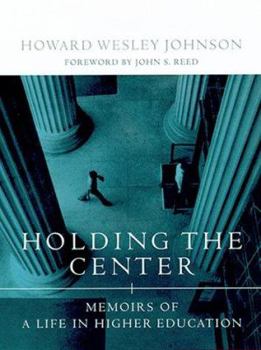Holding the Center: Memoirs of a Life in Higher Education
Select Format
Select Condition 
Book Overview
Howard Wesley Johnson has been associated with MIT for more than forty years and been a major influence on the modernization and expansion of many of its programs. He will be most remembered as a management educator and as MIT's president during the turbulent late 1960s and early 1970s. The title of his memoirs reflects his central, usually lonely position in those days, trying to hold together an institution often torn apart by the turmoil of the times. Johnson was more successful at navigating the minefields on campus than were many other college and university presidents, perhaps because he was always willing to listen to both sides and because his values were in the right place&-against the war in Vietnam, in favor of increased participation in the university by women and minorities, and concerned about environmental issues. As a professor and administrator at MIT, a corporate director, and an advisor to American government agencies and to museums and foundations, Johnson consistently sought both to understand and to apply the principles of good management.
Format:Hardcover
Language:English
ISBN:0262100797
ISBN13:9780262100793
Release Date:June 1999
Publisher:MIT Press (MA)
Length:344 Pages
Weight:1.64 lbs.
Dimensions:1.1" x 6.3" x 9.3"
Customer Reviews
2 ratings
Thrilling autobiography by MIT President from the late 60s
Published by Thriftbooks.com User , 15 years ago
Having worked at MIT for more than 35 years, I'm fascinated by how MIT became the most renowned technical university in the world. Howard Johnson's early life is also quite compelling, especially his years as a soldier in France at the close of WWII. From his description of events, it's clear he was smart and personable, but there seemed few signs during his youth of the greatness to follow. It seemed remarkable to me that he didn't get his PhD, but he never explains how he succeeded in academia without it. Indeed he doesn't seem to have been scholarly, there are no technical publications mentioned; he seems instead to have excelled as a program administrator at MIT's Sloan School of Management, quickly moving from professor to Dean, and jumping over previous bosses to become president in 1966, just in time for the political, social and cultural unrest of the 1960s. Going through these times of enormous stress, when he seems to have held MIT together, caused him to switch quickly from president to chairman of the MIT Corporation after just five years, but it was in that role, which he held for a dozen years, that he truly excelled, not just bringing MIT into prominence as one of the top overall universities in the world, but also serving on government commissions and corporate boards, working internationally, and turning Boston's Museum of Fine Arts into a world-class institution as chairman of their trustees. Through it all he seemed to remain a simple, unassuming and unpretentious person who valued people and believed in communication. He must have been extremely likable and inspired great confidence. I recommend this book highly for those who enjoy autobiography and memoirs, and those interested in MIT or university administration, and those interested in what happened on college campuses during the 60s protests.
Some People Make It Look Easy
Published by Thriftbooks.com User , 24 years ago
I attended the Massachusetts Institute of Technology from September 1964 through June 1972; I worked at the MIT Lincoln Laboratories in the summers of 1968 and 1970. I was given this book by the MIT Alumni Association, and found it to be remarkable in its truthful rendition of events that I lived through, and things that came afterwards (going to the Museum of Fine Arts in Boston in the 1990s), and seeing that Howard Johnson guided MIT through the late 1960s and beyond and the Museum of Fine Arts into a rebirth, and made it all look so easy. I look forward to the video that should accompany this!





